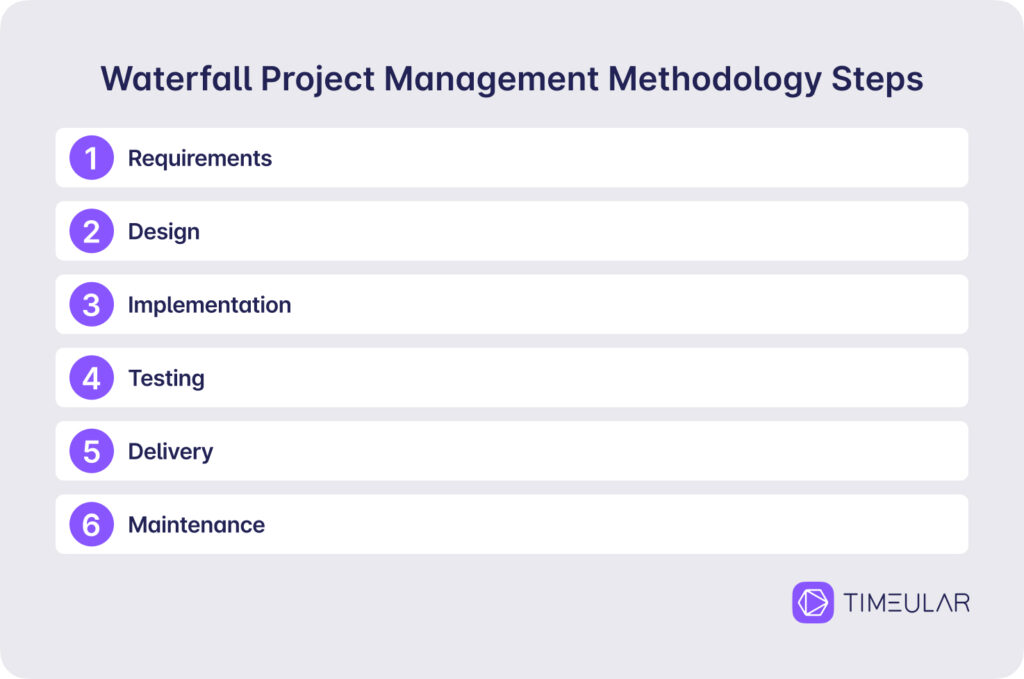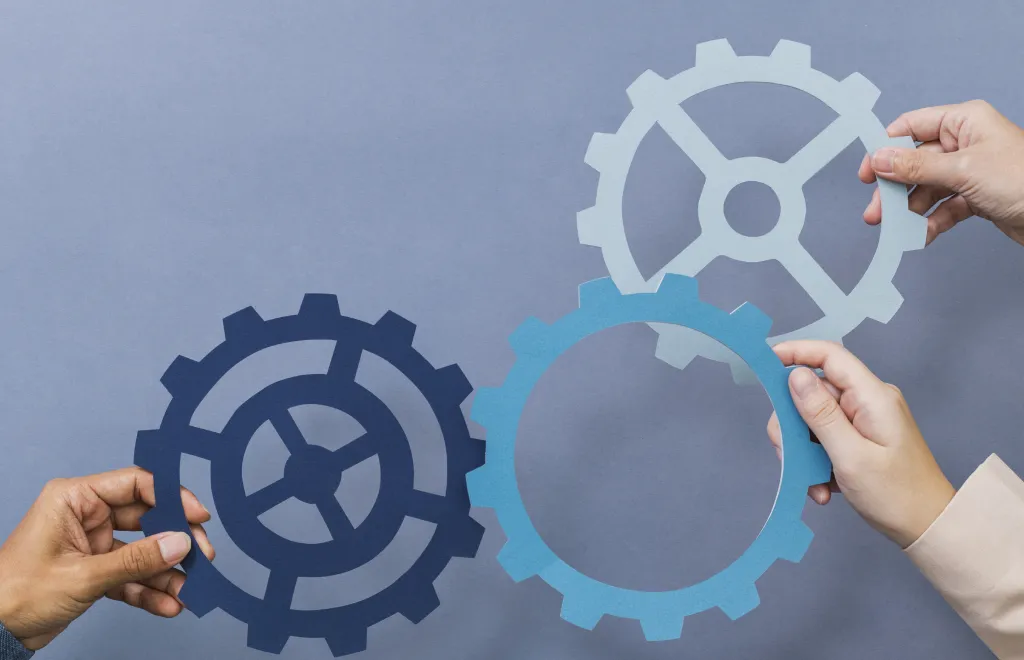Wasserfall-Projektmanagement-Methodik
Die Projektmanagement-Methodik des Wasserfalls ist recht einfach und effektiv für den Erfolg Ihres Projekts.
Bei diesem Modell wird jedes Projekt in eine Handvoll Phasen unterteilt, die linear ablaufen. Wenn Sie jede Phase in ihrer Reihenfolge abschließen, können Sie zur nächsten übergehen, und so weiter.

Hole dir deine Schritt-für-Schritt-Anleitung für die Zeiterfassung als Projektmanager
Sobald Sie die Umsetzungsphase erreicht haben, ist Ihr Ziel erreicht. Dieser Artikel gibt Ihnen einen vollständigen Leitfaden über das Konzept, die Phasen, die Vorteile und die Nachteile der Wasserfall-Methodik.
Lesen Sie auch: Was ist Projektmanagement?
Was ist die Waterfall-Projektmanagement-Methode?
Die Projektmanagement-Methode Wasserfall ist eine lineare Technik, die am häufigsten für Software-Entwicklungsprojekte verwendet wird.
Der Name leitet sich von der Strömung des Wasserfalls ab, die aufgrund ihrer Abwärtsbewegung mit den Stufen dieses Modells übereinstimmt.
Seit seiner Einführung im Jahr 1970 ist es als eine der weltweit am häufigsten verwendeten Projektmanagementmethoden anerkannt.
Bei der Wasserfallmethode müssen Sie jede Projektphase abschließen, um zur nächsten übergehen zu können. Wenn Sie in dieses Modell investieren wollen, müssen Sie Phasen wie Entwurf, Test, Wartung, Implementierung, Bereitstellung und Anforderungen durchlaufen.
Es gibt vier wesentliche Grundsätze für die Einführung der Waterfall-Projektmanagement-Methode:
- Trennung der einzelnen Phasen: Bei der Strukturierung jeder Phase müssen Sie die einzelnen Phasen definieren und voneinander trennen, indem Sie sie wie oben beschrieben kategorisieren.
- Planen Sie bis ins letzte Detail: Ein vollständiges Briefing mit allen Details ist der Schlüssel zum Erfolg Ihres Projekts im Rahmen der Wasserfall-Methodik.
- Linearer Durchbruch: Sie müssen jede Phase abschließen, bevor Sie zur nächsten Phase übergehen. Sie können nicht zur nächsten Phase übergehen und zur vorherigen zurückkehren. Sie schaden Ihrem Projekt erheblich, wenn Sie den natürlichen Fluss nicht respektieren.
- Bewahren Sie alles dokumentiert auf: Stellen Sie sicher, dass Sie während der Arbeit an jeder Phase jede Art von Dokumentation hinterlassen, um das Team in Zukunft zu unterstützen. Es ist auch ein hervorragendes System, um es allen zu zeigen, die nicht so stark involviert sind, aber auf den neuesten Stand gebracht werden müssen, wie z. B. die Interessengruppen.
Lesen Sie auch: Was ist Projektverfolgung?
Welches sind die 6 Phasen der Waterfall-Projektmanagement-Methodik?
Die 6 Phasen der Wasserfall-Projektmanagement-Methodik sind Anforderungen, Entwurf, Implementierung, Test, Lieferung und Wartung. Werfen wir einen Blick auf jede einzelne.

1. Anforderungen
In dieser Phase erstellt der Projektleiter die Liste der Anforderungen und Unterlagen, die für den Abschluss des Projekts und der Phase selbst erforderlich sind.
Dokumentationen wie Interviews, Briefings, eine Auswahl von Regeln oder sogar Aufzählungspunkte sind einige der Dinge, die zu Ihren Gunsten sein werden, wenn Sie sie haben. Sobald Sie alles vorbereitet haben, können Sie zum nächsten Schritt übergehen.
Eine Projektmanagement-Checkliste ist ein Dokument, das in dieser Phase sehr hilfreich sein kann.
2. Entwurf
Nachdem die richtigen Anforderungen und die entsprechende Dokumentation erstellt wurden, ist es an der Zeit, das Workflow-Modell für den Rest des Projekts zu entwerfen.
Anhand der in der ersten Phase erstellten Dokumente können Sie sehen, was Sie tun müssen, um das gesamte System zu entwerfen. Hier beginnt das Team mit der Definition der erforderlichen Programmierung sowie der Hardware- und Softwareausstattung, die den Weg ebnen soll.

Kostenloses eBook: Das Handbuch für Projektmanager zur Zeiterfassung
Hole dir deine Schritt-für-Schritt-Anleitung für die Zeiterfassung als Projektmanager
3. Umsetzung
Hier kommt die eigentliche Arbeit zum Tragen.
Ihr Team beginnt sich zu bewegen und sich um die anstehenden Aufgaben zu kümmern. Von der Kodierung und Programmierung mit der Dokumentation und Design, die zuvor zur Verfügung gestellt wurde, können sie in dieser Phase erstellen.
Ziel ist es, ein aussagekräftiges und endgültiges Produkt zu liefern.
4. Prüfung
In dieser Phase wird sichergestellt, dass die vorangegangenen Tests richtig waren.
Nach dem Entwurf und der Umsetzung der einmal festgelegten Anforderungen ist es nun an der Zeit zu prüfen, ob alles nach Plan verläuft.
Es ist normal, dass Sie einige Unstimmigkeiten finden, aber wenn sie schwerwiegender sind als Sie erwartet haben, müssen Sie möglicherweise sofort mit dieser Methode beginnen.
5. Lieferung des Produkts
Zu diesem Zeitpunkt ist alles gut gelaufen und Sie können Ihr Produkt in die Welt entlassen. Da das Produkt fertig ist, ist diese Phase die Gelegenheit, Ihr endgültiges und getestetes Produkt zu veröffentlichen.
Lesen Sie auch: Was ist Projektberichterstattung?

6. Wartung
Nach der Lieferung des Endprodukts muss noch eine letzte Phase folgen, die an die Wartung des gerade gelieferten Produkts erinnert. Da es ein Potenzial für mögliche Probleme gibt, arbeitet das Team an deren Lösung, um das Produkt in der bestmöglichen Qualität zu erhalten.
Wie bereits in der Testphase erwähnt, kann es sein, dass Sie bei Problemen, die nicht leicht zu beheben sind, wieder von vorne anfangen müssen.
Lesen Sie unseren Leitfaden, um herauszufinden, was Tigerteams sind und wie sie Ihnen bei der Lösung von Problemen in Ihrem Projekt helfen können.

Vorteile der Wasserfall-Projektmanagementmethode
Unter den verschiedenen Methoden, die Ihr Projekt unterstützen, ist diese eine der besten, da sie traditionelle Elemente enthält und einfach zu befolgen ist.
Im Folgenden finden Sie eine Auswahl von Vorteilen, die Sie davon überzeugen könnten, es an Ihre Arbeitstechnik anzupassen:
- Ohne die Beteiligung der Betroffenen wird es keine wiederkehrenden Anfragen geben;
- Alle neuen Entwickler, die in irgendeiner Phase der Methode einsteigen, werden dank eines klaren Briefings schnell auf den neuesten Stand gebracht;
- Die Analyse des Projektfortschritts ist noch deutlicher;
- Es ist möglich, das Budget und den Zeitplan für jede Phase sowie für das gesamte Projekt fast genau abzuschätzen;
- Die Entwickler können einige häufige Fehler während der einzelnen Phasen erkennen und sie vor der Implementierung leicht beheben.

Kostenloses eBook: Das Handbuch für Projektmanager zur Zeiterfassung
Hole dir deine Schritt-für-Schritt-Anleitung für die Zeiterfassung als Projektmanager
Warum ist die Zeiteinschätzung im Projektmanagement wichtig?
Nachteile der Wasserfall-Projektmanagementmethode
Obwohl es sich bei dieser Projektmanagementtechnik um ein einfaches Instrument handelt, weist sie einige Nachteile auf, auf die Sie achten sollten:
- Eine zu frühe Planung vor Beginn der Reise kann Ihrem Projekt schaden:
- Aufgrund der möglichen Länge der einzelnen Phasen dieser Methode kann die Durchführung Ihres Projekts länger dauern;
- Für die Beteiligten ist es schwierig, ein vollständiges Briefing zu erstellen, ohne die Möglichkeit zu haben, einige Aspekte zu ändern;
- Die Kunden sind nicht so stark involviert, wie sie es bei anderen Modellen gewesen wären;
- Wenn sich ein Teil der Projektphasen verzögert, verzögert sich auch der Rest, was sich auf die endgültige Lieferung auswirkt.
Wer kann die Waterfall-Projektmanagement-Methode anwenden?
Diese Methode wird vor allem von Ingenieuren und Projektmanagern verwendet, die dieses Modell für die Entwicklung ihrer Projekte nutzen.
Es ist ein perfektes Instrument für ein Projekt, bei dem alles bis ins Detail festgelegt ist. Es muss ein vollständiges und klares Briefing geben, damit Sie mit dieser speziellen Methodik fortfahren können.
Ähnlicher Artikel: Die beste Zeiterfassungs-App für die Softwareentwicklung
FAQ's
Wer hat die Waterfall-Projektmanagement-Methode entwickelt?
Winston W. Royce entwickelte 1970 die Waterfall-Projektmanagementmethode.
Welche Projekte werden nach der Wasserfall-Methode durchgeführt?
Die meisten Projekte, bei denen diese Methodik zum Einsatz kommt, sind in Branchen wie dem Baugewerbe, der IT und der Softwareentwicklung angesiedelt.
Welche Unternehmen verwenden die Waterfall-Methode?
Das bekannteste Unternehmen, das die Wasserfall-Methodik anwendet, ist Toyota.
Was ist der Unterschied zwischen einer Wasserfall- und einer agilen Projektmanagement-Methode?
Erstens braucht man keinen Projektmanager, während er bei der agilen Methode unerlässlich ist. Außerdem handelt es sich um eine flexible Methode, die während ihres Verlaufs Änderungen zulässt. Bei der agilen Methode haben Sie einen starreren Prozess, der keinerlei Änderungen zulässt.
Schlussfolgerung
Wenn Sie diesen Artikel lesen, werden Sie sehen, dass diese Methode etwas ist, das Sie in Ihrer Arbeitsmethode ausprobieren können, um die Erfolgsquote in Ihrem Projekt zu erhöhen.
Wie jedes Modell hat auch dieses seine Vor- und Nachteile, und genau deshalb ist dieser Leitfaden so wichtig. Sie können aus Ihrer Perspektive bestimmen, ob die Wasserfall-Methodik der richtige Weg für Sie und Ihr Team ist.
Der Trick, um das volle Potenzial dieser Methode auszuschöpfen, besteht darin, sich in jeder Phase zu engagieren und zu übertreffen. Auf diese Weise werden Sie eine reibungslose und reichhaltige Erfahrung sowie einen strukturierten Plan für Ihr Projekt haben.
Das könnte dich auch interessieren: